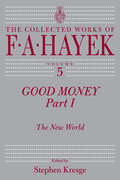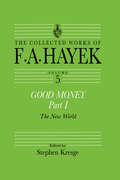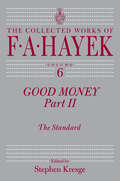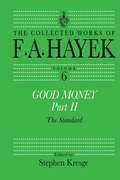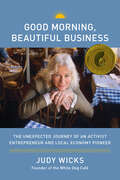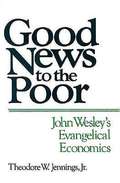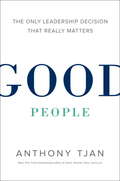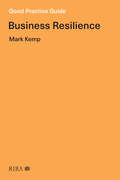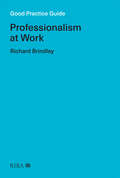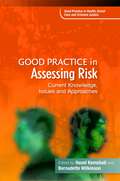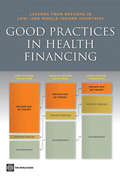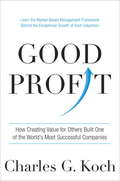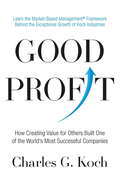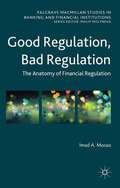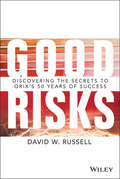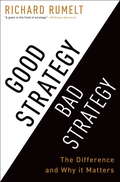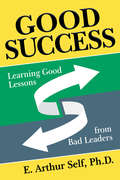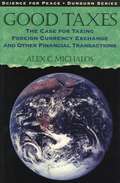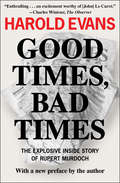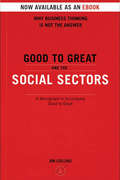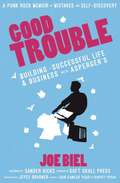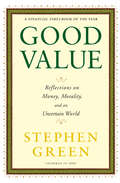- Table View
- List View
Good Money, Part I: The New World (The Collected Works of F. A. Hayek #5)
by F. A. HayekThe first part of this two-volume set presents seven articles by the Nobel Prize–winning economist on business cycles and the quantity theory of money. The two volumes of Good Money present a comprehensive chronicle of F.A. Hayek’s writings on monetary policy. Together, they offer readers an invaluable reference to some of his most profound thoughts about money.Good Money, Part I: The New World includes seven of Hayek’s articles from the 1920s that were written largely in reaction to the work of Irving Fisher and W. C. Mitchell. Hayek encountered Fisher’s work on the quantity theory of money and Mitchell’s studies on business cycles during a US visit in 1923–24. These articles attack the idea that price stabilization was consistent with the stabilization of foreign exchange and foreshadow Hayek’s general critique that the whole of an economy is not simply the sum of its parts.“Intellectually [Hayek] towers like a giant oak in a forest of saplings.” —Chicago Tribune
Good Money, Part I: Volume Five of the Collected Works of F.A. Hayek (The Collected Works of F.A. Hayek)
by Stephen KresgeThrougout his life Hayek had a profound interest in money and its role within the economy. This volume, together with Volume Six, Good Money, Part Two, collect all of Hayek's significant writings on money. Together they amply demonstrate both the significance of 'sound money' in Hayek's economic vision, and Hayek's importance as a monetary theorist.
Good Money, Part II: The Standard (The Collected Works of F. A. Hayek #6)
by F. A. HayekThe second part of this collection presents five articles that lay the foundation for some of the Nobel Prize–winning economists most controversial ideas.The two volumes of Good Money present a comprehensive chronicle of F.A. Hayek’s writings on monetary policy. Together, they offer readers an invaluable reference to some of his most profound thoughts about money.Good Money, Part II: The Standard offers five more of Hayek’s articles that advance his ideas about money. In these essays, Hayek investigates the consequences of the “predicament of composition.” This principle works on the premise that the entire society cannot simultaneously increase liquidity by selling property or services for cash. This analysis led Hayek to make what was perhaps his most controversial proposal: that governments should be denied a monopoly on the coining of money.“One of the great thinkers of our age who . . . revolutionized the world’s intellectual and political life.” —Former President George Herbert Walker Bush
Good Money, Part II: Volume Six of the Collected Works of F.A. Hayek (The Collected Works of F.A. Hayek)
by Stephen KresgeThrougout his life Hayek had a profound interest in money and its role within the economy. Money plays a critical part in his 1920s work on the trade cycle, which attempts to integrate capital theory and monetary theory. As late as the 1970s, Hayek was advocating radical reform of the monetary system, suggesting that the supply of money be turned over to private enterprise.This volume, together with Volume Six, Good Money, Part Two, collect all of Hayek's significant writings on money. Together they amply demonstrate both the significance of 'sound money' in Hayek's economic vision, and Hayek's importance as a monetary theorist.
Good Morning, Beautiful Business: The Unexpected Journey of an Activist Entrepreneur and Local-Economy Pioneer
by Judy WicksIt's not often that someone stumbles into entrepreneurship and ends up reviving a community and starting a national economic-reform movement. But that's what happened when, in 1983, Judy Wicks founded the White Dog Café on the first floor of her house on a row of Victorian brownstones in West Philadelphia. After helping to save her block from demolition, Judy grew what began as a tiny muffin shop into a 200-seat restaurant-one of the first to feature local, organic, and humane food. The restaurant blossomed into a regional hub for community, and a national powerhouse for modeling socially responsible business.Good Morning, Beautiful Business is a memoir about the evolution of an entrepreneur who would not only change her neighborhood, but would also change her world-helping communities far and wide create local living economies that value people and place as much as commerce and that make communities not just interesting and diverse and prosperous, but also resilient.Wicks recounts a girlhood coming of age in the sixties, a stint working in an Alaska Eskimo village in the seventies, her experience cofounding the first Free People store, her accidental entry into the world of restauranteering, the emergence of the celebrated White Dog Café, and her eventual role as an international leader and speaker in the local-living-economies movement.Her memoir traces the roots of her career - exploring what it takes to marry social change and commerce, and do business differently. Passionate, fun, and inspirational, Good Morning, Beautiful Business explores the way women, and men, can follow both mind and heart, do what's right, and do well by doing good.
Good News to the Poor: John Wesley's Evangelical Economics
by Theodore W. JenningsThis provocative volume illuminates a dimension of John Wesley's theology that has received insufficient attention: his deep and abiding commitment to the poor. By focusing on the radical nature of Wesley's "evangelical economics," Theodore W. Jennings, Jr. , provides an important corrective to the view that Wesley was concerned with the salvation of souls only, and not also with the social conditions of human beings.
Good Novels, Better Management: Reading Organizational Realities in Fiction
by Barbara Czarniawska-Joerges Pierre Guillet de MonthouxThis collection of essays demonstrates how novels are not only comparable, but often superior to the case histories used in business education. As many novelists have had personal experience of working in organizations, their work combines introspective insight with analytical skill.
Good People: The Only Leadership Decision That Really Matters
by Anthony TjanGood people are your organization’s most critical asset. But what does it really mean to be good?Leaders love to say that any company is only as good as its people, but tend to evaluate candidates and employees more by their measurable accomplishments than by their “softer” qualities, like integrity, compassion, and other values. Bestselling author Anthony Tjan is leading a movement to change the way we think about goodness so that we can become better judges of people and create more goodness in ourselves, in others, and in our organizations. Tjan argues that while competence is necessary, real goodness must also encompass values; a fantastic résumé can never compensate for mediocre character. In Good People, he provides a clear language to discuss goodness, redefining it as a lifelong, proactive commitment that, like any skill, can be exercised, honed, and taught. When leaders prioritize goodness in themselves and in others, they can create lasting cultures and tremendous value. Drawing from his own experiences as an entrepreneur and venture capitalist, Tjan also taps into the wisdom of his relationships and interviews with extraordinary innovators, executives, artists, academics, teachers, and role models from all disciplines and walks of life. The cases and profiles shared include: Harvard Business School Dean Nitin Nohria, who has called for balancing leadership of competency with leadership of character; Supreme Court Justice Sonia Sotomayor, who has never forgotten her roots and shows profound kindness to her staff and clerks; Hollywood talent manager Shep Gordon, who has counseled his clients on the importance of generosity and gratitude; legendary venture capitalist Henry McCance, whose success proves that humbly ceding the spotlight to others makes room for their greatness; and master jazz musician Clark Terry, who devotedly mentored the young, blind pianist Justin Kauflin. Packed with practical yet often surprising advice, Good People establishes a new language and framework you can use to evaluate, develop, and lead with goodness. Tjan will convince you that there is a hard truth in the “soft stuff” of business, and that choosing and working well with good people is truly the only leadership decision that really matters.
Good Practice Guide: Business Resilience
by Mark KempArchitecture can be a high risk and low-income profession. Planning to manage risks is essential. Workloads tend to be cyclical and managing lean periods and booms whilst being prepared for the next downturn is a key requirement. This book is a how-to guide to build business resilience into your architectural practice, offering methods for managing business-critical events and crises. It shows you how to analyse trouble, pre-emptively tackle pitfalls and gives you confidence in decision-making to stay ahead. Featuring case studies with expert insight into sole shareholder and director experience of a small practice, it’s aimed across all levels with straightforward, honest and accessible advice. It is structured with people and organisations as the core framework, exploring practice, staff, clients, projects, consultants and providers. It provides operational advice on the day-to-day running of practice and how to respond to disruption.
Good Practice Guide: Fees
by Stephen Brookhouse Patrick FarrallArchitects are finding the procurement landscape increasingly complex and competitive. This book shows practitioners the ways that fees are calculated, negotiated and managed. It will increase your understanding of the different fee-earning roles for architects, professional services contracts, how to calculate sustainable fee levels and improve negotiation skills. It also includes information on how to monitor and manage fees and the resources required to deliver projects, managing change in the scope of the project and related services, where to add value and to highlight risk areas that may impact on sustaining the business. Case studies explain good and bad practice to illustrate effective fee management, drawn from the authors’ direct experience as practitioners and investigating client complaints.
Good Practice Guide: Making Successful Planning Applications
by Colin HaylockHow do you obtain permission? How can you satisfactorily tackle objections? How can you convince planning officers of the value of your work? Drawing on substantial experience from both applicant and local planning authority perspectives, this book provides tactics and practical steps to help architects secure early validation of applications and successful outcomes. It’s a practical guide to understanding the planning system and maximizing the potential for successful outcomes. Readers will develop a greater understanding of the principles that are vital in the preparation and negotiation of applications against the very complex detail of regulatory arrangements.
Good Practice Guide: Professionalism at Work
by Richard BrindleyProfessionalism is not automatic with qualification. It is decided by the manner in which you carry out your professional life – the conduct and qualities that you bring to your role. In architecture, it is founded on the principles of honesty, integrity and competence, and a concern for the environment and others. As a trusted expert, it is essential that you gain respect for your skills and knowledge while maintaining veracity and transparency in your relationships and dealings with clients, end users, design and construction professionals and the wider public. With a focus on professional judgement, this book is a personal guide on how to be a self-aware and successful practitioner, aspiring to best practice. It will give you the confidence to create meaningful industry connections and handle contractual disputes, insurance and negligence claims while maintaining a high standard of conduct. By paying attention to business planning, financial processes, good management and effective communication, it will help you to protect your practice’s reputation and increase profitability and cashflow. Ultimately, it will enable you to not only avoid professional pitfalls but to benefit from positive working relationships.
Good Practice in Assessing Risk
by Bernadette Wilkinson Edited by Hazel KemshallMaintaining a balance between managing and assessing risk and upholding the required high standards of practice in health and social care can be demanding, particularly in the current climate of increased preoccupation with the difficult tensions between rights, protection and risk-taking. Good Practice in Assessing Risk is a comprehensive guide to good practice for those working with risk, covering a wide variety of health, social care and criminal justice settings including child protection, mental health, work with sex offenders and work with victims of domestic violence. The contributors discuss a range of key issues relating to risk including positive risk-taking, collaborating with victims and practitioners in the design of assessment tools, resilience to risk, and defensibility. The book also explores the role of bureaucracy in hindering high quality professional practice, complex decision-making in situations of stress or potential blame, and involving service users in assessment. This book reflects the latest policy and practice within health, social care and criminal justice and will be an invaluable volume to all professionals working in these fields.
Good Practices in Health Financing
by Hugh R. Waters Pablo Gottret George SchieberFor humanitarian reasons and the concern for households' economic and health security, the health sector is at the center of global development policy. Developing countries and the international community are scaling up health systems to meet the Millennium Development Goals (MDGs) and are improving financial protection by securing long-term support for these gains. Yet money alone cannot buy health gains or prevent impoverishment due to catastrophic medical bills; well structured, results-based financing reforms are needed. Unfortunately, global evidence of "successful" health financing policies that can guide the reform effort is very limited and therefore the policy debate is often driven by ideological, one-size-fits-all solutions. 'Good Practices in Health Financing: Lessons from Reforms in Low- and Middle-Income Countries' attempts to begin to fill the void by systematically assessing health financing reforms in nine low- and middle-income countries that have managed to expand their health financing systems to both improve health status and protect against catastrophic medical expenses. The participating countries are: Chile, Colombia, Costa Rica, Estonia, the Kyrgyz Republic, Sri Lanka, Thailand, Tunisia, and Vietnam. The study seeks to identify common enabling factors of their good performance. While the findings for each country are important, collectively they send a clear message to the global community that more attention is needed to define "good practice" and then to evaluate and disseminate the global evidence base.
Good Profit: How Creating Value for Others Built One of the World's Most Successful Companies
by Charles G. KochTHE UNIQUE MANAGEMENT SYSTEM FROM A LEGENDARY CEOIn 1967, Charles Koch took the reins of his father’s company and began the process of growing it from a $21 million start-up into a global corporation with revenues of about $115 billion, according to Forbes. So how did this MIT engineer manage grow Koch Industries into one of the largest private companies in the world today with growth exceeding that of the S&P 500 by almost 30-fold over the last five decades? Through his unique five-dimensional management process and system called Market-Based Management. Based on five decades of cross-disciplinary studies, experimental discovery, and practical implementation across Koch companies and their 100,000 employees worldwide, the core objective of Market-Based Management’s framework is as simple as it is effective: to generate good profit. What is good profit? Good profit results when a company creates value for customers in a way that helps them improve their lives. Good profit is the result of innovations that customers freely vote for with their own dollars; it’s the result of business decisions that create long term value for everyone--customers, employees, shareholders, and society.While you won't find the Koch Industries name on your home’s stain-resistant carpet, your baby’s more comfortable but absorbent diapers your stretch denim jeans, or your television with a better clarity screen, MBM™ drove these innovations and many more. Here, drawing on revealing, honest stories from his five decades in business – the company’s many successes as well as its stumbles – Koch walks the reader step-by-step through the five dimensions of Market-Based Management to show stockholders, entrepreneurs, leaders, students -- and innovators, supervisors and employees of all kinds, in any field --how to apply the principles to generate Good Profit in their organizations, companies, and lives.From the Hardcover edition.
Good Profit: How Creating Value for Others Built One of the World's Most Successful Companies
by Charles G. KochA NEW YORK TIMES BESTSELLERIn 1961, Charles Koch joined his father's Wichita-based company, then valued at $21 million. Six years later, following his father's death, he was named chairman of the board and CEO of Koch Industries, Inc. Today, Koch Industries' estimated worth is $100 billion - making it one of the largest private companies in the world. Koch exceeds the S&P 500's five-decade growth by 27-fold, and plans to double its value on average every six years. What exactly does this company do and why is it so remarkably profitable? While you won't find the Koch name on your stain-resistant carpet, stretch denim jeans, the connectors in your smartphone or your baby's ultra-absorbent diapers, Charles Koch's Market-Based Management® system, intended to generate good profit, drove these innovations and many more. Good profit results from products and services that customers vote for freely with their money; products that help improve people's lives. It results from a culture where employees are empowered to act entrepreneurially to discover customer preferences and the best ways to satisfy them. Good profit is the earnings that follow when long-term value is created for everyone - customers, employees, shareholders and society. Readers will learn to:· Craft a vision for how a business can thrive in spite of disruption and ever-changing consumer values· Find and retain a workforce possessing both virtue and talent (the first being the more important)· Award employees with ownership and decision rights based on their comparative advantages and proven contributions, rather than job title· Motivate all employees to maximise their contributions with effectively structured incentives so employees' compensation is limited only by the value they create - not budgets or company-wide policy A must-read for any leader, entrepreneur or student, as well as those who want a more civil, fair and prosperous society, GOOD PROFIT is destined to rank as one of the greatest management books of all time.
Good Regulation, Bad Regulation
by Imad A. MoosaSince the 2007 2008 global financial crisis, there has been much debate about the role of financial regulation and the causes of financial instability in the industry. Where studies commonly question the value of a regulated rather than free market , this book focuses on the differentiation of 'good regulation' and 'bad regulation'. This book highlights the need for financial regulation to combat corruption, and the integral link that exists between corruption and financial instability. The author evaluates the benefits and shortcomings of specific types of regulation, drawing on recent examples to illustrate each argument. The book presents compelling arguments for the regulation of leverage, liquidity, payday loans and securitisation; and debates the negative aspects of the regulation of short selling, and high-frequency trading, and of Basel-style banking regulation. The author argues that there is no free-market solution to financial instability, and rejects the idea of 'too big to fail'.
Good Risks: Discovering the Secrets to ORIX's 50 Years of Success
by David W. RussellGet inside Japan's invisible behemoth to see the future of global businessGood Risks is a fascinating insight into ORIX, a global giant whose business empire straddles the world, but which has managed to remain out of the media spotlight for half a century. Award winning author David Russell explains how this Japanese company has transcended its national identity to become a global player, and what that means for everyone else. In a series of one-on-one interviews with senior executives at ORIX companies around the world, readers gain a firsthand glimpse of the inner workings of this "invisible" corporate group that controls hundreds of billions of dollars. Interviews with the company President and Chairman in Tokyo provide rare insight into the thought leaders at the highest levels, and a contribution by the Chairman himself discusses the hard realities of globalization and the keys to success in the coming decade.The key concept that is lost in the Japan vs. China vs. US vs. EU battle is that the business landscape has changed drastically, making national boundaries anachronistic. Companies such as IBM, Disney, Apple, and Microsoft long ago stopped being "American" firms; they are global competitors that take advantage of their deep knowledge of the US markets, but have no special allegiance to the United States. This book argues that this is the future of all large-scale business, as already exemplified by ORIX.Learn how one executive steered ORIX's meteoric rise from an unknown start-up to an unseen global giantExplore the coming realities of the global business sceneDiscover why HQ location will be little more than historical accidentSee how ORIX impacts the Chinese, Indian, and American firms that follow its leadThe business scene unfolding today is not "international" or "multinational", but an increasingly unified, global battleground. The rise of ORIX charts the future of business, and Good Risks provides the details and insights business leaders need to anticipate tomorrow's changes.
Good Strategy Bad Strategy: The Difference and Why It Matters
by Richard RumeltClears out the mumbo jumbo and muddled thinking underlying too many strategies and provides a clear way to create and implement a powerful action-oriented strategy for the real world Developing and implementing a strategy is the central task of a leader, whether the CEO at a Fortune 100 company, an entrepreneur, a church pastor, the head of a school, or a government official. Richard Rumelt shows that there has been a growing and unfortunate tendency to equate Mom-and-apple-pie values, fluffy packages of buzzwords, motivational slogans, and financial goals with “strategy.” He debunks these elements of “bad strategy” and awakens an understanding of the power of a “good strategy.” A good strategy is a specific and coherent response to—and approach for overcoming—the obstacles to progress. A good strategy works by harnessing and applying power where it will have the greatest effect in challenges as varied as putting a man on the moon, fighting a war, launching a new product, responding to changing market dynamics, starting a charter school, or setting up a government program. Rumelt’snine sources of power—ranging from using leverage to effectively focusing on growth—are eye-opening yet pragmatic tools that can be put to work on Monday morning.Surprisingly, a good strategy is often unexpected because most organizations don’t have one. Instead, they have “visions,” mistake financial goals for strategy,and pursue a “dog’s dinner” of conflicting policies and actions.Rumelt argues that the heart of a good strategy is insight—into the true nature of the situation, into the hidden power in a situation, and into an appropriate response. He shows you how insight can be cultivated with a wide variety of tools for guiding yourown thinking.Good Strategy/Bad Strategy uses fascinating examples from business, nonprofit, and military affairs to bring its original and pragmatic ideas to life. The detailed examples range from Apple to General Motors, from the two Iraq wars to Afghanistan, from a small local market to Wal-Mart, from Nvidia to Silicon Graphics, from the Getty Trust to the Los Angeles Unified School District, from Cisco Systems to Paccar, and from Global Crossing to the 2007–08 financial crisis.Reflecting an astonishing grasp and integration of economics, finance, technology, history, and the brilliance and foibles of the human character, Good Strategy/Bad Strategy stems from Rumelt’s decades of digging beyond the superficial to address hard questions with honesty and integrity.From the Hardcover edition.
Good Success: Learning Good Lessons from Bad Leaders
by E. Arthur SelfThe purpose of Good Success is to help readers learn and integrate into their life and career the good lessons learned from bad leaders. Bad leaders drive organizational dysfunction, incarnate indecision, and deplete personal energy and team resolve. Also, bad leaders exhaust resources and hope. But, through Good Success readers gain the knowledge and the lessons to overcome the damage, shape their awareness, and build new courage to navigate beyond the chaos. Good Success enable recovery from the effects of bad leadership, creates the means to achieving self-mastery, brings closure to previous negative circumstances, and so much more. It is possible that those who work for bad leaders have already written-off any chance of benefiting from the chaos that they create. If so, Good Success helps readers draw a valuable inheritance from the F.E.A.R. (failures, experiences, anxieties, roadblocks) they’ve seen bad leaders produce.
Good Taxes: The Case for Taxing Foreign Currency Exchange and Other Financial Transactions
by Alex C. MichalosFinancial transactions taxes are in force in all the major developed countries except the USA and Canada. Typically the tax is 0.25% or less, paid whenever stocks and shares or bonds, etc. change hands. The tax originally proposed by Tobin would be a new tax applicable to all international transactions in which currency is exhanged. A similar tax in North America could bring in billions of dollars, even if the tax were as low as 0.1%. In Good Taxes, Alex Michalos puts forth the argument in favour of a financial transactions tax. He looks at the tax as being a benefit to the countries that collect it, as well as a possible solution to such problems as world poverty and the underfunding of the United Nations. Good Taxes provides a thorough analysis of the debate over the proposed tax. Michalos traces the development of the debate back to the proposed Tobin Tax, then details the arguments for and against the implementation of a financial transactions tax. The conclusion is one that is sure to have an impact in North American financial circles.
Good Times, Bad Times: The Explosive Inside Story of Rupert Murdoch
by Harold EvansA renowned journalist&’s &“vivid&” account of his battle with Murdoch after the global media baron bought the Times of London (Chicago Tribune). In 1981, Harold Evans was the editor of one of Britain&’s most prestigious publications, the Sunday Times, which had thrived under his watch. When Australian publishing baron Rupert Murdoch bought the daily Times of London, he persuaded Evans to become its editor with guarantees of editorial independence. But after a year of broken promises and conflict over the paper&’s direction, Evans departed amid an international media firestorm. Evans&’s story is a gripping, behind-the-scenes look at Murdoch&’s ascension to global media magnate. It is Murdoch laid bare, an intimate account of a man using the power of his media empire for his own ends. Riveting, provocative, and insightful, Good Times, Bad Times is as relevant today as when it was first written. With details on the scandalous deal between Murdoch and Margaret Thatcher, this updated ebook edition includes an extensive new preface by Evans, the New York Times–bestselling author of Do I Make Myself Clear?, discussing the Rupert Murdoch phone-hacking scandal.
Good To Great And The Social Sectors
by Jim CollinsBuilding upon the concepts introduced in Good to Great, Jim Collins answers the most commonly asked questions raised by his readers in the social sectors. Using information gathered from interviews with over 100 social sector leaders, Jim Collins shows that his "Level 5 Leader" and other good-to-great principles can help social sector organizations make the leap to greatness.
Good Trouble: Building a Successful Life and Business with Asperger's (Punx Ser.)
by Sander Hicks Joe Biel Joyce Brabner<p>In 1996, everything about Joe Biel's life seemed like a mistake. He was 18, he lived in Cleveland, he got drunk every day, and he had mystery health problems and weird social tics. <p>All his friends' lives were as bad or worse. To escape a nihilistic, apocalyptic worldview and to bring reading and documentation into a communal punk scene, he started assembling zines and bringing them in milk crates to underground punk shows. Eventually this became Microcosm Publishing. But Biel's head for math was stronger than his ability to relate to people, and it wasn't until he was diagnosed with Asperger's Syndrome that it all began to fall into place. <p>This is the story of how, over 20 years, one person turned a litany of continuing mistakes and seeming wrong turns into a happy, fulfilled life and a thriving publishing business that defies all odds.</p>
Good Value: Reflections on Money, Morality and an Uncertain World
by Stephen GreenCan one be both an ethical person and an effective businessperson? Stephen Green, an ordained priest and the chairman of HSBC, thinks so. In Good Value, Green retraces the history of the global economy and its financial systems, and shows that while the marketplace has delivered huge advantages to humanity, it has also abandoned over a billion people to extreme poverty, encouraged overconsumption and debt, and ravaged the environment.How do we reconcile the demands of capitalism with both the common good and our own spiritual and psychological needs as individuals? To answer that, and some of the most vexing questions of our age, Green takes us on a lively and erudite journey through history, looking for lessons in the work of economists and philosophers, businessmen and poets, theologians and novelists, playwrights and political scientists. An essential business book by a man who is uniquely qualified to write it, Good Value is a timely and persuasive analysis of the most pressing financial and moral questions we face.
